Dell Precision T7920 Workstation Test System
Here is a list of how our Dell Precision T7920 Workstation is equipped:
- Processor: Dual Intel Xeon Platinum 8260 2.4GHz, 3.9GHz Turbo, 24C/48 Threads
- Memory: 96GB 12x8GB DDR4 2933MHz RDIMM ECC
- Graphics Card: Nvidia Quadro RTX 8000, 48GB, 4DP, VirtualLink
- OS Boot: Dell Ultra-Speed Drive Duo PCIe SSD x8 Card with 1x M.2 512GB PCIe NVMe Class 50 Solid State Drive
- Internal RAID Controller: MegaRAID SAS 9460-16i 12Gb/s PCIe SATA/SAS HW RAID controller (4GB cache)
- HDDs in Raid 10: 4x 3.5″ 4TB 7200rpm SATA Enterprise Hard Drive
- Thunderbolt 3: PCIe card – 2 Type C Ports, 1 DP
- OS: Windows 10 Pro for Workstations
Realistically, most of our users will order a dual Intel Xeon Platinum 8260 configuration with 12x 32GB DDR4 DIMMs or more. Our memory channels are full using 1 DIMM per channel in this configuration but our capacity is relatively low. This system can scale well beyond 1TB of memory, something that the high-end desktop offerings simply cannot match.
The CPU we will be using is dual Intel Xeon Platinum 8260 2.4GHz (24 cores/ 48 threads.) These two processors give the system a full 48 cores/ 96 threads.
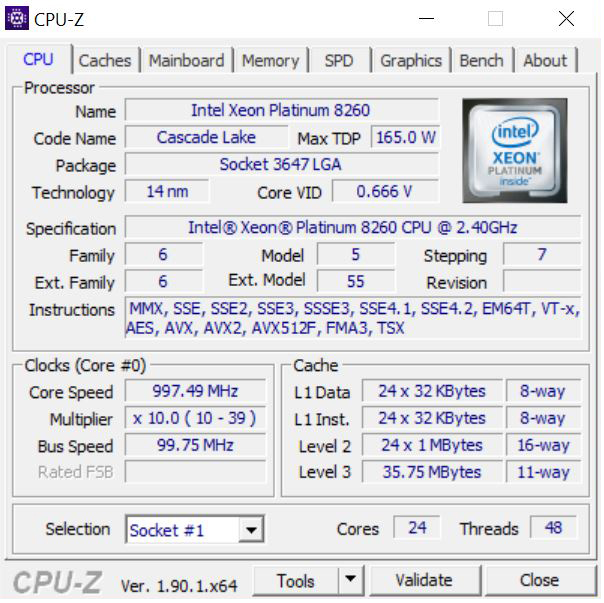
The Intel Xeon Platinum 8260 is a very capable CPU, the base speed is 2.4GHz but can Turbo up to 3.9GHz. It also has the full feature set support that Intel offers in this generation including dual-port FMA AVX-512 and DL Boost.
Let us continue with performance testing.
Dell Precision T7920 Performance Testing
As we move along with the motherboard testing we felt it was time to clean up our database and results in graphs, some new benchmarks we have not run before but will be adding them in, or newly updated benchmarks render past versions obsolete so we must start over with that benchmark. We also note that at this time the Dell Precision T7920 Workstation is one of the first current dual-processor Xeon Scalable workstations we have reviewed, as a result, we do not have comparison benchmark numbers at this time for other systems in Windows. You can see that we have tested the Platinum 8260 and 8260L previously on STH in Linux, and have a large dataset for Xeon Scalable Linux results. For this review, we will chart our Windows benchmark results so that we can add others later.
We also ran the NVIDIA Quadro RTX 8000 in a separate review so that we could look at the RTX 8000 and compare it to the large number of GPUs we have reviewed to date. System benchmarks with the RTX 8000 were run with the Dell Precision T7920 workstation and shown in this review. If you want to get a sense of relative performance for GPU options, check the Quadro RTX 8000 piece.
Dell Precision T7920 Workstation CrystalDiskMark
CrystalDiskMark is a well-known benchmark to test your HDD or SSD’s.
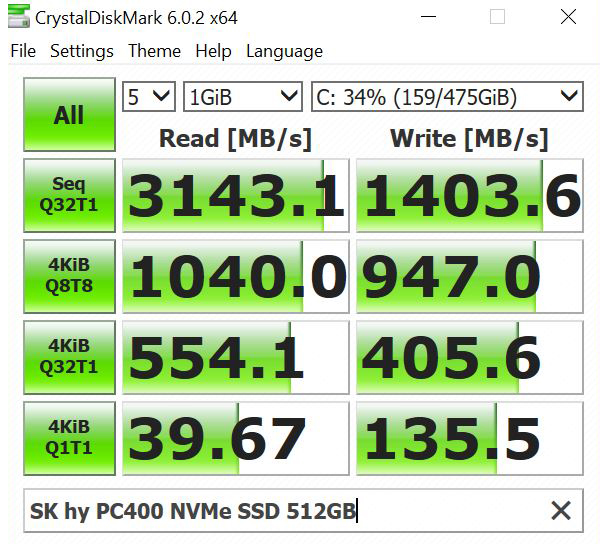
Here the SK.hynix PC400 NVMe SSD performed very well. At the same time, large manufacturers source SSDs from multiple vendors to ensure supply chain continuity so Dell can offer different 512GB drives if needed in the future.
Dell Precision T7920 Workstation AIDA64 Memory Test
AIDA64 memory bandwidth benchmarks (Memory Read, Memory Write, and Memory Copy) measure the maximum achievable memory data transfer bandwidth.
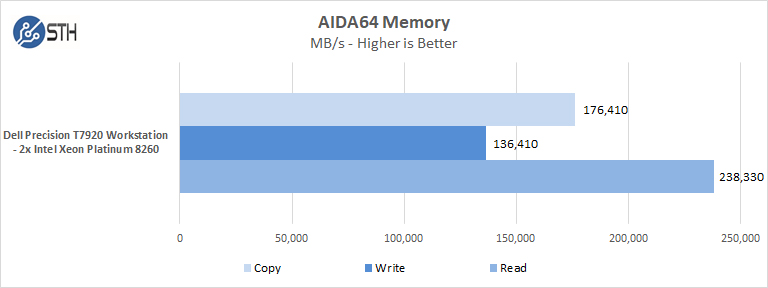
We have 96GB 12x8GB DDR4 2933MHz RDIMM ECC Low Profile sticks on our Dell Precision T7920 Workstation which boosts memory read speeds a great deal. If you are looking for full memory bandwidth, then you will want 12 DIMM configurations. We also suggest that using higher-capacity DIMMs can be a worthwhile upgrade.
Dell Precision T7920 Workstation Cinebench R15
Here are our Cinebench R15 results:
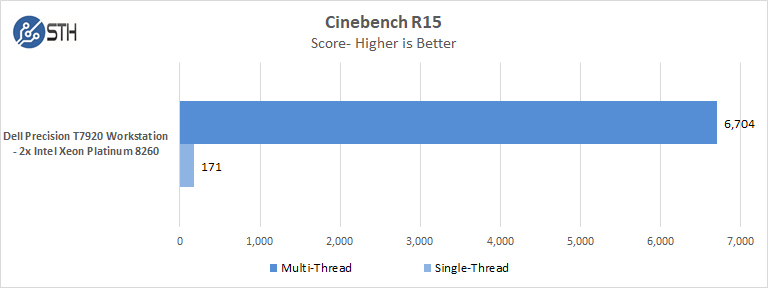
We ran Cinebench R15 several times, this is the best score we received which reinforces Cinebench does better with CPU’s that have a larger number of cores. Single-core performance on the Intel Xeon Platinum 8260 is very good, multi-core shows high performance.
Dell Precision T7920 Workstation Cinebench R20
Here is the newer Cinebench R20 result:
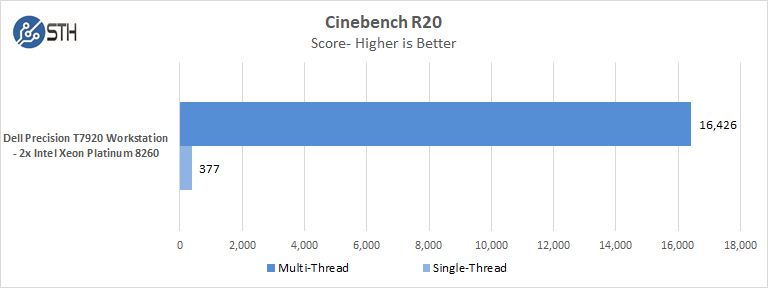
We have only just started using Cinebench R20, it shows the Intel Xeon Platinum 8260 again shows impressive results.
If you compare to our Linux results, you would use our c-ray 8K results to see similar scaling.
Dell Precision T7920 Workstation Geekbench 4
Geekbench 4 is a popular benchmark so we are running it here.
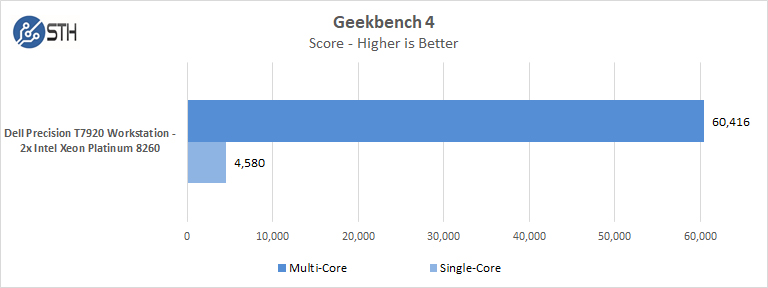
The Intel Xeon Platinum 8260 generates very good results, but Geekbench is known to struggle at higher core counts and with more than one CPU. That is something we found setting a Geekbench 4 world record earlier this year. Some software will not scale well across multiple CPUs despite the maturity of the architecture.
Next, we are going to look at system performance benchmarks.




I’ve got one of these in the office – great machine, and I love the layout of the motherboard (lenovo is also using a layout like that now too), but theres some things to look out for depending on what you’re using it for and how you’re using it:
1- if you have nosy coworkers who like looking at the hardware in the chassis, just show them the machine before its turned on, since opening the chassis during operation will shut the machine down while triggering a chassis intrusion alarm. At least on my early model, it also bugged out the dell support assist feature so it permanently thinks a fan is broken, when that fan was never installed on that model.
2- in order to keep the overall width of the unit within reason for product dimensions and cooling reasons, the clearance for cards is roughly equivalent to a 3U server. In places, that is actually slightly less, because the side panel latch has an internal bump running the height of the server. Tall cards like some consumer GPUs will not fit in this case, nor will short-length consumer GPUs that have outward/side facing (as opposed to front facing) pcie power plugs, as the bump will be in the way of the cable. Long standard height consumer GPUs with side facing pcie power plugs will fit, but you might have to squeeze the cabling a bit
3- There were 3 included pcie 8/6pin cables. If you are using consumer GPUs, you may need to buy additional cables from dell or use splitters. At the time I bought my unit, dell did not have the cables for purchase individually, but I managed to cludge an equivalent cable together out of adapters, since the PSU breakout board’s connectors for the pcie power plugs have the same pinout as (cont in next)
3 (cont)- the plug would on the pcie card as well.
4- If you want NVME support, you’ll need an adapter. You can bifurcate the lanes, but not explicitly – there is a setting in the bios (i forget which, but it has to do with pcie ssds), that you can toggle. Out of the box it was set to a setting where it would not detect dell’s own quad nvme adapter card, and dell’s enterprise support doesn’t have enough experience with those cards (or even the product specifications on hand) to do more than manually walk through trial and error experimentation of figuring out how to use the card in this machine. Turns out its that bios setting.
5- If you need audio for the work you intend to do on this machine and are expecting to get by with the motherboard audio since its usually ‘good enough’ on highend prosumer motherboards, you will be disappointed. Get a soundcard for this – I didn’t need amazing audio or anything, just audio good enough to listen to people speaking during meetings and checking the contents of files I was processing or working with, but the built in audio was really bad.
It should be kept in mind that my forewarnings are based on a very early unit (I got it within a month of launch, since I needed something more powerful right then in order to complete a project)
Despite these issues I encountered, I still very much like this machine, and they wont be problems for everyone.
Thanks for the info Syr. I am curious about your point #3 — I have avoided Dell workstations because they only offer 8/6 pin PCIe power connectors, while most consumer GPUs (e.g. 2080 Ti) require 8/8 connectors. It would be great to learn more about how you figured this out.
Dell, HP and Lenovo have very nice laptops, their workstations… not really value for money
Hi Michael – to clarify what I had meant by 8/6 was that the cables included with the system supported the full 6+2 connector, but only 1 per cable. The system came with 3 such cables pre-installed, but had 4 available headers, thus I was able to determine the pinout by simply matching the cables on the card side to the PSU breakout board side. It helped that Dell used standard cable color codes (yellow for +12 and black for 0).
I’m using 2x 1080ti cards in the system with 2x 8-pin plugs on them for a total of 4 plugs required, so I had to cobble together a cable out of adapters to power the second plug on the second card from the 4th empty plug on the PSU breakout board.
Syr–thanks for the reply! So it sounds like there are a maximum of 4 x 8 PCIe plugs available. That’s enough for 2 consumer GPUs. A 3rd GPU may not be possible.
If Dell went for AMD route, a system with 2x EPYC 7352 would be much cheaper with more PCIe lanes.
How well did the Thunderbolt work?
Thanks for the review. Also curious about the Thunderbolt support.
I hope this will help someone who is considering the purchase of a Dell workstation make a better decision. I loved my old T7600 – it worked perfectly for close to 6 years. There was no question in my mind when I replaced it – I was going with a Dell Precision Workstation. Since purchasing the T7920 in the summer of 2018, Dell has replaced it twice and replaced several major components in those replacements.
Today, a Dell level 3 tech told me they have known of systemic issues with the T7920.
I have Dell 7920 Workstation , purchased in March 2018. Although , There was a problem in the begining , now working OK. Can some one advise , how to add Thunderbolt card ? It does not have TB header . Although a area is marked TBT , but no socket on it.
In fact i see the same unsoldered spot as shown in one the photos ( when Zoomed out) . However , at the back i see the card with TB ports.
$25,000 machine. With a megaraid 9460 NVME Hardware Raid Controller alternatively configured with a quad of garbage 4tb 7.2k sata rust disks. LOL wtf? huge fail!
Plus why in the world throw a single garbage nvme on the mainboard and call it a day?
If Dell is watching, probably want to fire the guy that sent out your hottest high end professional workstation for a performance review with THAT raid controller not running a raid10 of nvme’s. You could have smashed 7000MB/s easy. PLUS on RAID10 redundancy.
@Syr Why bifurcate lanes and run NVME’s in software raid? You’ll soak the CPU and effectively turn a $25k workstation into a very expensive hardware raid controller.
Unless you like your CPU busy doing things a CPU shouldn’t busy itself with doing?
Dell implemented that thing with Secure Boot that if you have non-Dell GPU, you’ll have to turn it off and on multiple times with no guaranteed result. Which is honestly annoying. No wonder it’s cheaper on eBay than HP or Lenovo. I bought one and had to return it (I believe it just died due to endless powercycles). Should’ve paid slightly more $ for HP or Lenovo thus saving time and emotional energy.